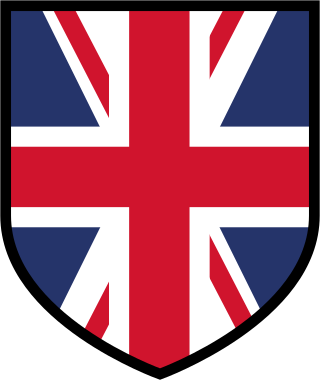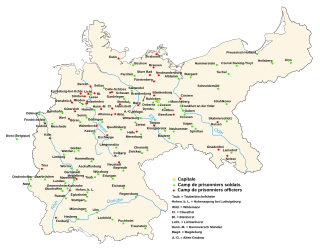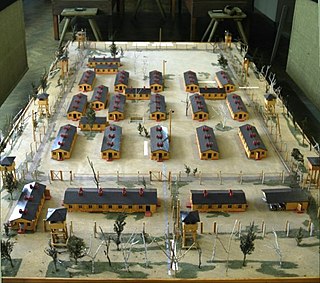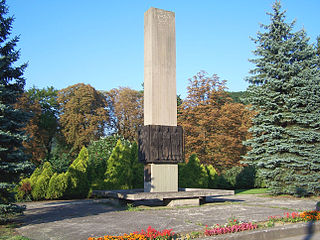
The British Free Corps was a unit of the Waffen-SS of Nazi Germany during World War II, made up of British and Dominion prisoners of war who had been recruited by Germany. The unit was originally known as the Legion of St George. Research by British historian Adrian Weale has identified 54 men who belonged to this unit at one time or another, some for only a few days. At no time did it reach more than 27 men in strength.

During World War I, German prisoner-of-war camps were run by the 25 Army Corps Districts into which Germany was divided. Around 2.4 million men were World War I prisoners of war in Germany.

Stalag Luft III was a Luftwaffe-run prisoner-of-war (POW) camp during the Second World War, which held captured Western Allied air force personnel.

Stalag III-A was a German World War II prisoner-of-war camp at Luckenwalde, Brandenburg, 52 kilometres (32 mi) south of Berlin. It housed Polish, Dutch, Belgian, French, Yugoslav, Russian, Italian, American, Romanian, British and other Allied POWs.

Stalag XI-B and Stalag XI-D / 357 were two German World War II prisoner-of-war camps (Stammlager) located just to the east of the town of Fallingbostel in Lower Saxony, in north-western Germany. The camps housed Polish, French, Belgian, Soviet, Italian, British, Yugoslav, American, Canadian, New Zealander and other Allied POWs.
Friesack Camp or Camp Friesack was a special World War II prisoner of war camp where a group of Irishmen serving in the British Army volunteered for recruitment and selection by Abwehr II and the German Army. The camp was designated Stalag XX-A (301) and located in the Friesack area, Brandenburg region. The training and selection by Abwehr II and the German Army occurred during the period 1940–1943.
John Codd was an Irish-born British Army corporal during World War II, who went on to serve in the German Intelligence service (Abwehr) and the Sicherheitsdienst, the foreign intelligence arm of the SS.

Friesack is a town in the Havelland district, in Brandenburg, in north-eastern Germany. It is situated 22 km (14 mi) northeast of Rathenow, and 25 km (16 mi) southwest of Neuruppin. It is known for its Mesolithic archaeological site.

Stalag IV-B was one of the largest prisoner-of-war camps in Germany during World War II. Stalag is an abbreviation of the German Stammlager. It was located 8 km (5.0 mi) north-east of the town of Mühlberg in the Prussian Province of Saxony, just east of the Elbe river and about 30 mi (48 km) north of Dresden. From 1944 to 1945 it belonged to the Province of Halle-Merseburg. Now, the area is in Brandenburg. A sub-camp, sometimes identified as Stalag IV-B/Z,Stalag 304 or Stalag IV-H was located at Zeithain, 10 km (6.2 mi) to the south in Saxony.

Stalag VIII-D was a German World War II prisoner-of-war camp (Stammlager) located at the outskirts of Teschen,. It was built in March 1941 on the grounds of a former Czech barracks. It was later known as Stalag VIII-B.
Stalag VIII-E was a German World War II prisoner-of-war camp located next to the village of Neuhammer, Silesia. It was about 15 km (9.3 mi) south of the camps Stalag VIII-C and Stalag Luft III at Sagan, Silesia. It was built on a large German Army training ground that is still in use today by the Polish Land Forces' 10th Armoured Cavalry Brigade. It housed Polish, French, and Soviet POWs.
Stalag IX-C was a German prisoner-of-war camp for Allied soldiers in World War II. Although its headquarters were located near Bad Sulza, between Erfurt and Leipzig in Thuringia, its sub-camps – Arbeitskommando – were spread over a wide area, particularly those holding prisoners working in the potassium mines, south of Mühlhausen.

Stalag IV-A Elsterhorst was a World War II German Army prisoner-of-war camp located south of the village of Elsterhorst, near Hoyerswerda in Saxony, 44 kilometres (27 mi) north-east of Dresden. It held Polish, French, Belgian, British, Serbian, Soviet, Dutch, Italian, American, Slovak, Czech, Bulgarian and other Allied POWs.

Stalag XVIII-A was a World War II German Army (Wehrmacht) prisoner-of-war camp located to the south of the town of Wolfsberg, in the southern Austrian state of Carinthia, then a part of Nazi Germany. A sub-camp Stalag XVIII-A/Z was later opened in Spittal an der Drau about 100 km (62 mi) to the west.
Stalag XIII-D Nürnberg Langwasser was a German Army World War II prisoner-of-war camp built on what had been the Nazi party rally grounds in Nuremberg, northern Bavaria.

Oflag XXI-C was a German Army World War II prisoner-of-war camp for officers (Offizierlager) located in Ostrzeszów in German-occupied Poland. It held mostly Norwegian officers arrested in 1942 and 1943, but also Dutch, Italian, Serbian and Soviet POWs. Originally most Norwegian soldiers and officers had been released after the end of the Norwegian campaign, but as resistance activities increased, the officers were rearrested and sent to POW camps.

Stalag XXI-D was a German World War II prisoner-of-war camp based in Poznań in German-occupied Poland, operated in 1940–1945. It held Polish, French, British, Belgian, Dutch, Serbian, Soviet and Italian POWs.
Stalag I-F was a German World War II prisoner-of-war camp located just north of the city of Suwałki in German-occupied Poland.

George Frank McLardy MPS was a member of the British Union of Fascists, a British Nazi collaborator and an Unterscharführer in the Waffen-SS British Free Corps during the Second World War.

Nazi Germany operated around 1,000 prisoner-of-war camps during World War II (1939-1945).














